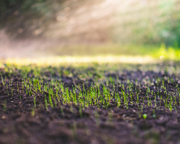Yates Account
Join now
Create a Yates account today!
Sign up to join the Yates Garden Club for monthly e-mails packed with seasonal inspiration, tips for success & exclusive promotions.
Plus if you’re a Garden Club member you can take part in the Yates Growing Community - a blog to share successes, get advice & win prizes in fun challenges along the way!

Forgot password
Enter the email address associated with your account, and we'll email you a new password.

Kikuyu is a vigorous growing warm climate grass seed and will survive where other lawn seed types would struggle or need a lot of maintenance.
Kikuyu is excellent for high traffic areas, coastal gardens and drought prone districts, in frost free regions of New Zealand. In coastal areas (sandy soil types) it's possibly the only type of lawn seed that will survive. It can be established to slow down coastal erosion from shifting sand.
Yates Kikuyu Lawn Seed is a blend of fast germinating Ryegrass and Kikuyu seed. The Ryegrass acts as a 'nurse crop' to minimise soil or sand erosion and reduce weed competition while the slower Kikuyu seedlings establish. Once established, the Kikuyu will take over the space. Kikuyu is ideal for the lawn at the bach or crib, as it needs very little regular maintenance.
Note. The Kikuyu seed takes longer to germinate, approximately 6 weeks. The pack contains a ratio of 90% Ryegrass to 10% Kikuyu (this isn't as bad as it sounds, as kikuyu seed is very fine). Make sure to shake and mix the contents thoroughly for even distribution of both seed types.
Because Kikuyu is often used to establish a lawn on sandy soil, it's important to keep up the watering for a longer period. For this reason, sowing in autumn is preferable to spring, due to the increased chances of rain to keep things moist. Sandy soil is usually low on organic material so work in Yates Dynamic Lifter Lawn Food to the soil before sowing. This gently feeds the seed as it germinates, ensuring quick establishment.
Sowing technique for your kikuyu seed is exactly the same as for other types of lawn seed. The addition of topsoil or a lawn soil mix will help with moisture retention and give the new Kikuyu seedlings something to take root into, in the short term. Cover the seed by raking in at right angles to the sowing direction.
A light mulch of pea or barley straw after you've sown your seed will also increase moisture retention, especially when sowing a lawn at the bach (you might not be there as much to water). The first 7 to 14 days are the most critical time to ensure moisture - don't let the sowed area dry out during this time.
Mowing
Once established it's recommended to regularly mow your Kikuyu at a height of 2-3 cm, to promote sideways growth from the kikuyu runners.
Feeding
Sandy soil doesn't hold on to nutrients as well as other soil types, so fertilisers can leach out pretty quickly. Yates Dynamic Lifter Lawn Food is the best option for sandy soil substrates, as it gently feeds the Kikuyu while boosting microbial life in the soil around the root zone. Lawn grass needs microbial activity to flourish, as it relies on microbes to unlock nutrients from fertiliser.
Weeding
There generally isn't a need for this as Kikuyu is a dominant variety and will suppress most of the competition. On the flip side, kikuyu can be invasive, so a close watch on surrounding gardens and non-grass areas needs to be maintained.
If you're considering kikuyu for a duneland area where native coastal grasses are under pressure, it's best to seek local expert advice before sowing.
















Share
Share this article on social media